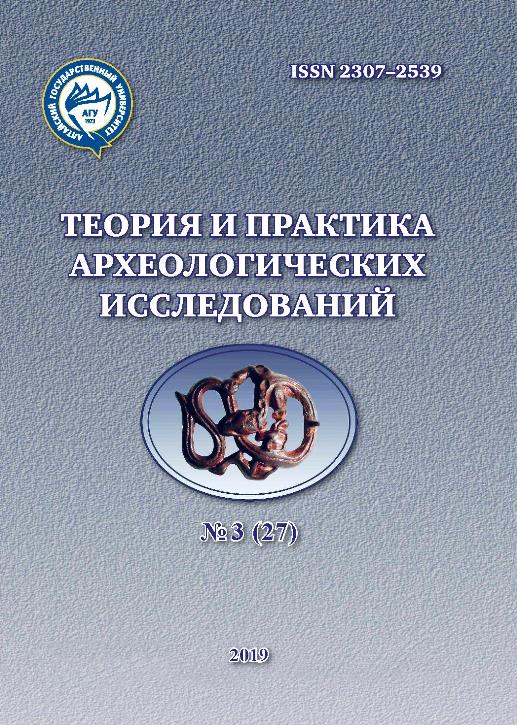STRUCTURE, SIMBOLISM AND ATTRIBUTIONS OF THE RITUAL COMPLEXES DURING THE JŌMON PERIOD ON THE JAPANESE ARCHIPELAGO
Abstract
Stone Age art of the Japanese Archipelago is tightly connected with the variety of ritual features dated by the Final Paleolithic – Jōmon periods (14–2,300 BP). By their scale they could be divided into “macrocomplexes”(rings of stone, mounds, shell-mounds), and “micro-complexes” (sets of artifacts within the dwellings, burials, and caches). In its turn, within macro-complexes (Hokkaido and Honshu Islands) there are structures with horizontal and vertical orientation; they are accompanied by numerous finds of clay figurines, fragments of vessels with anthropomorphic and zoomorphic symbols, and adornments of soft stones. Stone mazes (“sekibō”) are of special value: their sizes vary from several centimeters to 2,5 meters; they were found both in micro- and macro-complexes. In spite of the acidic soils which used to destroy the organics, multiple traces of pits and variety of wood-working tools allow suggesting that vertical megaliths were accompanied and even antedated by the series of wooden constructions. Japanese materials, from one side, fit well with the Eurasian context of vertical megaliths and wooden idols, and, from the other, correlate with the ancient cultures of the Pacific basin (Southeast Asia, Oceania, North- and South American coasts) with long-term traditions of stone and wooden totem poles with level-type representation of symbols and mythological personages.
Downloads
Metrics
References
Abiko S. Tōkyō-to Tabata kanjō tsumiishi ikō [Tabata Stone Circle, Tokyo]. Jōmon rando sukēpu [Jōmon Landscape]. Tokyo : UM Promotion, 2005. Pp. 151–160 (In Japanese).
Akimoto N. Ishi ni kometa jōmonjin no inori – Ōyu kanjōresseki [Jōmon People’s Players Put in Stone – Ōyu Stone Circle]. Iseki o manabu [Learn the Ruins]. Tokyo : Shinsensha, 2005. Vol. 17. 96 p. (In Japanese).
Jōmon jin no ishigami – Ōgata sekibō ni miru saigi kōi [The Stone Gods of Jōmon People – Ritual Activities Seen in Large Stone Rods]. Tokyo : Kokugakuin daigaku kenkyū kaihatsu suishin kikō gakujutsu shiryōkan kōkogaku shiryōkan bumon, 2010. 140 p. (In Japanese).
Dogū to kosumosu [Dogū, a Cosmos] / Miho Museum. Tokyo : Hatori, 2012. 341 p. (In Japanese). Ivanova D.A. Poselencheskie kompleksy kul’tury jōmon (na primere pamyatnika Sannai Maruyama) [Settlement Complexes of Jōmon culture (on the example of Sannai Maruyama site)]. Materialy 52-I Mezhdunar. nauch. stud. konf. [Materials of 52th International Student Scientific Conference]. Novosibirsk: Izd-vo NGU, 2014. Pp. 50–51.
Ivanova D.A. «Kamennye krugi» epokhi jōmon: prichiny vozniknoveniya i osobennosti konstruktsii [“Stone Circle” of Jōmon Period: the Reason of Appearance and Features of Structure]. Vos’mye Grodekovskie chteniya : Materialy mezhdunar. nauch.-prakt. konf, posvyashchennoi 70-letiyu Pobedy v Velikoi Otechestvennoi voine [The Eighth Grodekov Readings. Materials of International Scientific Conference, Dedicated to the 70-th Anniversary of Victory in the Great Patriotic War]. Khabarovsk : Khabarovskii kraevoi muzei im. N. I. Grodekova, 2015. Vol. III. Pp. 135–139.
Imafuku R. Chūbu chihō no jōmon kinen-mono [Jōmon Monuments in Central Japan]. Jōmon rando sukēpu [Jōmon Landscape]. Tokyo : UM Promotion, 2005. Pp. 161–166 (In Japanese).
Kinsei iseki II (jōmon jidai-hen). Ken’ei hojōseibi jigyō ni tomonau hakkutsu chōsa hōkoku-sho [Kinsei II Site (Jōmon Period). Excavation Report in Connection with the Development of the Prefectural Territory]. Kofu : Yamanashi-ken kyōiku iinkai, 1986. Vol. 41. 325 p. (In Japanese).
Komakino iseki hakkutsu chōsa hōkoku-sho [Komakino Site Excavation Report]. Aomori : Aomorishi kyōiku iinkai, 2006. Vol. 85. 192 p. (In Japanese).
Komissarov S.A., Azarenko Yu.A. O znachenii taivan’skikh megalitov [On the Significance of Taiwan Megaliths]. Problemy arkheologii, etnografii, antropologii Sibiri i sopredel’nykh territorii [Problems of Archaeology, Ethnography, Anthropology of Siberia and Neighboring Territories]. Novosibirsk : Izd-vo In-ta arkheologii i etnografii SO RAN, 2012. Vol. XVIII. Pp. 152–155.
Niitsu T. Chūbu sangaku chihō no syōiseki [Sites with Stone Circle of Central Mountain Region]. Kikan kōkogaku – Nihon-no sutōn sākuru [Quarterly Archaeology – Japanese Stone Circle]. 2007. Vol. 101. Pp. 69–75 (In Japanese).
Shimizu A. 4-pon no ōgata sekibō o tomonau shikiishi ikō – Tōkyō-to Kunitaich-shi Midorikawa Higashi iseki [Remains of Stone-paved Floor Dwelling with Four large Stone Rods]. Kikan kōkogaku – Jōmon bunka no kyōkai [Quarterly Archaeology – The Boarder of Jōmon Culture]. 2013. Vol. 125. Pp. 99–104 (In Japanese).
Tabarev A.V. Kamennye i derevyannye izvayaniya v kul’ture manten’ya-uankavilka, Ekvador [Stone and Wooden Statues in the Culture of the Mantegna-Huancaquilca, Ecuador]. Problemy arkheologii, etnografii,
antropologii Sibiri i sopredel’nykh territorii [Problems of Archaeology, Ethnography, Anthropology
of Siberia and Neighboring Territories]. Novosibirsk : Izd-vo In-ta arkheologii i etnografii SO RAN, 2015.
Vol. XXI. Pp. 405–408.
Tabarev A.V., Ivanova D.A., Nesterkina A.L., Solovieva E.A. Dzemonskaya traditsiya monumental’nykh sooruzhenii na Yaponskom arkhipelage: istoki, osobennosti, rasprostranenie [The Jōmon Megalithic Tradition in Japan: Origins, Features, and Distribution]. Arkheologiya, etnografiya i antropologiya Evrazii [Archaeology, Ethnology and Anthropology of Eurasia]. 2017. Vol. 54(4). Pp. 45–55. DOI: 10.17746/1563-0102.2017.45.4.045-055.
Takada K. Jōmon no ie to mura no fūkei – Goshono iseki [Landscape of Home and Village on Jōmon Culture– Goshono site]. Iseki o manabu [Learn the Ruins]. Tokyo : Shinsensha, 2005. Vol. 15. 93 p. (In Japanese).
Takada H. Ishikawa-ken Mawaki iseki [Mawaki Site, Ishikawa Prefecture]. Jōmon rando sukēpu [Jōmon Landscape]. Tokyo : UM Promotion, 2005. Pp. 191–198 (In Japanese.).
Taniguchi Ya. Ōgata sekibō no nokosare-kata: Hōki-ji no jōkyō to kōi no patān (tokushū jōmon jidai no ōgata sekibō) [Depositional Patterns and Processes of Jōmon Sekibō (Large Stone Rod)]. Gekkan kōkogaku jānaru [Monthly Archeology Journal], 2015. Vol. 678. Pp. 3–7 (In Japan.).
Togashi H. Nīgata-ken Achiyadaira iseki [Achiyadaira Site, Niigata Prefecture]. Jōmon rando sukēpu [Jōmon Landscape]. Tokyo : UM Promotion, 2005. Pp. 178–187 (In Japanese).
Yamamoto N. Kanjō mokuchūretsu kara mita jōmon jidai banki no chiiki shakai [On the Community Considered by the Wood Circle of the Final Jōmon Period]. Nagoya daigaku bungakubu kenkyū ronshū. Shigaku [The Journal of Faculty of Literature, Nagoya University. History]. 2009. Vol. 55. Pp. 25–38 (In Japanese). Habu J. Ancient Jomon of Japan / Ed. Rita P. Wright. Cambridge : Cambridge Univ. Press, 2004. 332 p.
Messages in Stone: Statues and Sculptures from Tribal Indonesia in the Collections of the Barbier- Mueller Museum. Geneva (CH) : Musée Barbier-Mueller, 1998. 208 p.
Pearson R. Archaeological Investigations in Eastern Taiwan // Asian Perspectives. 1968. Vol. XI. Pp. 137–156.
Van der Zee P. Bisj-poles: Sculptures from the Rain Forest. Amsterdam : KIT Publishers, 2007. 119 p.
Theory and Practice of Archaeological Research is a golden publisher, as we allow self-archiving, but most importantly we are fully transparent about your rights.
Authors may present and discuss their findings ahead of publication: at biological or scientific conferences, on preprint servers, in public databases, and in blogs, wikis, tweets, and other informal communication channels.
Theory and Practice of Archaeological Research allows authors to deposit manuscripts (currently under review or those for intended submission to ABS) in non-commercial, pre-print servers such as ArXiv.
Authors who publish with this journal agree to the following terms:
- Authors retain copyright and grant the journal right of first publication with the work simultaneously licensed under a Creative Commons Attribution License (CC BY 4.0) that allows others to share the work with an acknowledgement of the work's authorship and initial publication in this journal.
- Authors are able to enter into separate, additional contractual arrangements for the non-exclusive distribution of the journal's published version of the work (e.g., post it to an institutional repository or publish it in a book), with an acknowledgement of its initial publication in this journal.
- Authors are permitted and encouraged to post their work online (e.g., in institutional repositories or on their website) prior to and during the submission process, as it can lead to productive exchanges, as well as earlier and greater citation of published work (See The Effect of Open Access).








2.jpg)



